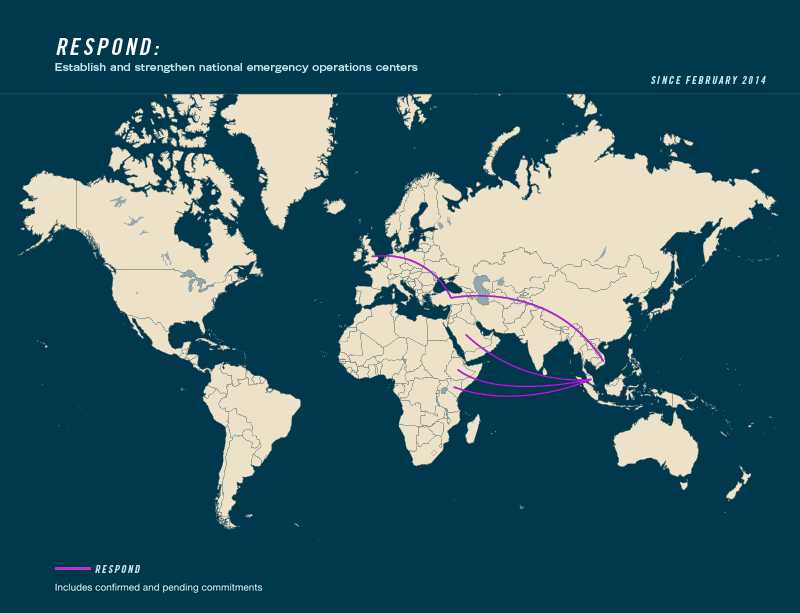Global Health Security Agenda: GHSA Emergency Operations Centers Action Package (GHSA Action Package Respond-1)
 Five-Year Target: Every country will have a public health Emergency Operations Center (EOC) functioning according to minimum common standards; maintaining trained, functioning, multi-sectoral rapid response teams (RRTs) and “real-time” biosurveillance laboratory networks and information systems; and trained EOC staff capable of activating a coordinated emergency response within 120 minutes of the identification of a public health emergency.
Five-Year Target: Every country will have a public health Emergency Operations Center (EOC) functioning according to minimum common standards; maintaining trained, functioning, multi-sectoral rapid response teams (RRTs) and “real-time” biosurveillance laboratory networks and information systems; and trained EOC staff capable of activating a coordinated emergency response within 120 minutes of the identification of a public health emergency.
As Measured by: Documentation that a public health EOC meeting the above criteria is functioning.
Desired National Impact: Effective coordination and improved control of outbreaks as evidenced by shorter times from detection to response and smaller numbers of cases and deaths.
Country Commitments to Action Package:
- Leading countries: Malaysia, Turkey
- Contributing countries: Ethiopia, Kenya, Saudi Arabia, United Kingdom, Vietnam
- Contributing international organizations: FAO, OIE, WHO
Five-Year Action Items:
Actions shall be coordinated with FAO, OIE and WHO as relevant international organizations.
- Conduct trainings and exercises on GHSA capabilities with regional partners.
- Establish or upgrade physical space for the national public health EOC to render it immediately accessible to the lead public health authority, with adequate space for a broad multi-sectoral response team; reliable power and communications; and capability to convene participants from ministries and other national and multinational partners as appropriate.
- Install and train staff on key applications (including but not limited to WebEOC, Red Sky, Dragon Fire, EPI-X, and Epi Info) for use in the national EOC.
- Designate and train personnel—including technical subject matter experts (e.g., physicians, veterinarians, epidemiologists, microbiologists) as well as support staff—and logistically commit to their rapid deployment as directed by the EOC (e.g., with vehicles and allowances necessary to transport personnel).
- Develop and field-test distance learning tools to train staff on public health emergency management topics.
- Develop train-the-trainer capacity and establishment of regional centers for advanced training to sustain and continuously enhance public health emergency management workforce skills.
- Establish One Health Committees with legislative support and cooperation between Ministries of Health and Agriculture.
- Ensure comprehensive emergency management training for core EOC leadership at the Ministries of Health and Agriculture. In collaboration with other key stakeholders, develop distance learning tools to train staff on public health emergency management topics. With international support, field test tools and sponsor visiting fellows for in-depth public health emergency management training at relevant national and international institutions.
- Install EOC infrastructure. This will include hardware and software to enable emergency management functions as well as software to enable data collection, analysis, and display.
- Ensure connectivity to public health surveillance and laboratory information systems in order to facilitate public health response decision making.
Baseline Assessment and Planning Activities
- Develop an appropriate planning framework.
- Review national laws and authorities enabling public health emergency management and define the mission of the public health EOC.
- Identify and establish liaisons with all relevant government ministries.
- Develop standards for staff competencies, infrastructure, and EOC systems.
- Develop procedures and protocols for EOC operations.
- Develop a country sustainability plan for EOC operations.
- Prepare an inventory of external stakeholders' activities.
- Convene technical consultations to review best practices, lessons learned, and tools under development for EOC and RRT operations.
- Conduct national training and exercises to determine performance baselines.
- Conduct an exercise on GHSA capabilities with regional partners to determine performance baselines.
Monitoring and Evaluation Activities
- Test the proficiency of personnel—including technical subject matter experts (e.g., physicians, veterinarians, epidemiologists, microbiologists) as well as support staff.
- Conduct communications exercises between the national EOC and all stakeholders to enhance sharing of public health information.
- Conduct after action reviews of all exercises and live activations of all EOC and RRT functions, and implement a capacity improvement plan using recommendations from the reviews.
9 “Minimum common standards” are defined as emergency management program standards such as the International Organization for Standardization (ISO) 22300 family of standards or national equivalents. WHO’s Emergency Response Framework could also be considered as a source of standards.
10 Rapid response teams (RRTs) are rostered, trained, multidisciplinary teams able to deploy to a public health emergency in any part of the country within 24 hours to investigate and characterize the epidemic, evaluate patients, collect clinical specimens, oversee containment measures, and communicate with public health authorities.
11 A “real-time” network or system is one in which information generated by one node in the network or system can be distributed to another node within the network or system within 60 minutes.
12 “Activating a coordinated emergency response” is defined as conducting a first conference call or meeting including all relevant emergency management sectors and functions (e.g., command/management, operations, planning, logistics, administration/ finance, and communications).
- Page last reviewed: September 30, 2014
- Page last updated: December 24, 2014
- Content source:
Global Health
Notice: Linking to a non-federal site does not constitute an endorsement by HHS, CDC or any of its employees of the sponsors or the information and products presented on the site.


 ShareCompartir
ShareCompartir